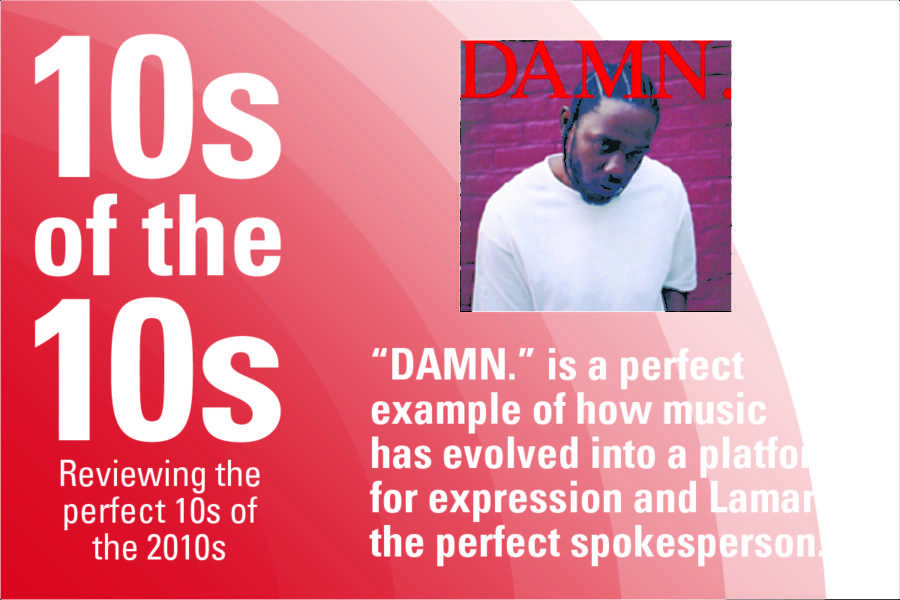10s of the 10s: Kendrick Lamar’s DAMN.
Kendrick Lamar’s album, “DAMN.” ranks as number one on Lamar’s personal list of his studio albums. Reviewer Collin Maguire believes “DAMN.” is one of Lamar’s most prominent albums, for more reasons than the awards it has earned.
October 1, 2019
Kendrick Lamar has cemented himself among the biggest names of hip-hop with a bedazzled discography. With projects like “To Pimp a Butterfly,” “Section.80,” “DAMN.” and “good kid m.A.A.d city” it’s no wonder many fans place him in high regard. Marking the peak of his discography is an entirely different issue.
Lamar has been referred to as Dr. Dre’s protege since he emerged onto the scene in 2010, signing with Dre’s label Top Dawg Entertainment. Three platinum studio albums later, Lamar has generated critical acclaim throughout the music industry. His influence even reached the Academy of Motion Picture Arts & Sciences music branch, as he assisted with the “Black Panther” and “Divergent” soundtracks.
In a 2017 interview with BigBoyTV Kendrick was asked to rank his studio albums without any external bias. In order, Lamar’s list consisted of: “DAMN.,” “good kid, m.A.A.d city,” “To Pimp a Butterfly” and “Section.80.”
“DAMN.” stands out as Lamar’s top project for an abundance of reasons. He states the 2017 project was a hybrid of his three prior studio albums in regards to the message from “To Pimp A Butterfly,” the sonics from “good kid, m.A.A.d city” and the rawness from “Section.80.”
In addition to “DAMN.” topping Kendrick’s personal ranking, the album swept the rap category at the 2018 Grammy Awards. Not only did the project receive five Grammys, but it also won a Pulitzer prize and Lamar made history as the first artist to receive the award for a hip-hop album.
The Pulitzer Board revered the album, calling it “a virtuosic song collection unified by its vernacular authenticity and rhythmic dynamism that offers affecting vignettes capturing the complexity of modern African-American life.”
Growing up around dangerous street activity, the Compton native remains in touch with his emotions. “DAMN.” is the perfect encapsulation of Lamar’s ability to harness emotion within his sound and prolific lyrical ability.
His refusal to work with artists who don’t own a mutual level of respect is showcased throughout his discography. He draws a star-studded group of producers and feature artists to compose “DAMN.” With features like Rihanna, U2 and Zacari, it is no question Lamar is particular about who he works with. Other contributors include Mike WiLL Made-It, BADBADNOTGOOD, The Alchemist, DJ Dahi, James Blake and Sounwave.
“DAMN.” begins with the fleeting, yet ominous, “BLOOD.,” a track in which Lamar has an encounter with a blind woman who says, “Oh yeah, you have lost something/ you’ve lost…your life,” as Lamar is killed by a gunshot.
Lamar draws comparisons of the raw, free-flowing nature of his debut studio album, “Section.80,” an album containing a lifetime of experience and expression. This sets the emotional benchmark for the remaining 13 tracks.
The following track, “DNA.,” makes a statement for Lamar as an artist. In this record he refers to the adversity he experienced as a kid growing up in the gang-oriented streets of Compton. Kendrick refers to his DNA as “soldier’s DNA/ born inside the beast,” as a tribute to the affliction caused by these streets.
In the final bridge of the song, talk show host Geraldo Rivera is sampled saying, “This is why I say that hip hop has done more damage to young African Americans than racism in recent years.” As Lamar cuts into the sound and targets those who have committed acts contributing to police brutality and the agenda of white nationalists in America.
Kendrick’s ability to remain lyrically powerful while simultaneously balancing his artistic mastery is placed in center stage throughout the duration of the album. The song “FEAR.” samples 24-Carat Black’s song “Poverty’s Paradise,” released in 1973. Kendrick addresses his biggest fear throughout the record: the fear of losing his wealth.
Adversity and discipline reveal themselves as key themes within this song as Kendrick discusses how his mother instilled fear in him as a child. However, his fear grew as he aged and his career began to take off. In verse four, Lamar addresses the fear of losing the image of himself: “I’m talkin’ fear, fear of losin’ creativity/ I’m talkin’ fear, fear of losin’ loyalty from pride.” Lamar is adamant about ending his artistic career on his own terms, and not letting the fear engulf him.
For many, “good kid, m.A.A.d city” is the staple of hip-hop in the 2010s. However, according to Lamar, it places second in his overall discography. The introspective nature of Lamar’s lyricism is present in both “DAMN.” and “good kid m.A.A.d city.”
“LOVE. FEAT. ZACARI.” is an incredibly lethargic, yet captivating track. The listener finds Lamar and Zacari reflecting on the deep intimacy that the concept of love brings to the table.
Lamar’s use of the line “backstroke oversea” refers to his desire for his fiance, Whitney Alford. Lamar intends to do anything for his partner because of how deep his love is.
The contrasting track, “LUST.,” signifies the tangible affection that comes with the feeling of lust. This acts as an inverse to “LOVE.” as Lamar highlights his physical desires rather than the wholesome feeling that accompanies love.
Lamar takes on the role of a conceited, lustfully driven individual throughout the duration of the song. Lamar says, “Wake up in the mornin’, thinkin’ ’bout money, kick your feet up/ Watch you a comedy, take a shit, then roll some weed up.” Ultimately, this acts as a shot at those who live a rather unproductive lifestyle driven by lustful activity. This line reveals itself as the record continues, calling for various beat switches.
While Lamar sounds rather simple as he spits, the complexity of the beat continues to grow. The general theme of self-destruction through an unhealthy, lustfully driven mindset is perpetuated as Lamar draws comparisons between sex and a reliance on drugs.
One of Lamar’s most prominent features is his ability to tell stories and convey a specific feeling within a song. “To Pimp a Butterfly” is his most prolific album in regard to the concept of emitting ideas into the ears of a listener. The 2015 release was nominated for 11 Grammys, second to none other than Michael Jackson.
The song “YAH.” contains a rather powerful background, along with a wonderfully addictive sound passed on by Lamar. The title of the song refers to God’s actual name “Yahweh.” The track begins with Kendrick saying, “I got so many theories and suspicions,” in relation to his 2012 interview with “Truth is Scary,” in which he states his belief the president holds no true power.
Lamar continues to toy with his words as the song continues. He says, “My world been ecstatic, I checked the signal that read—/ Buzzin’, radars is buzzin’.” The idea of verse one tying in with his chorus was executed perfectly. The concept of a radar refers to Lamar being aware of the criticism he receives from various news outlets, especially FOX news.
Kendrick continues the chorus saying, “Yah, yah, yah, yah,” believed to be a call for God. God is the one keeping Lamar informed, acting as his personal radar. It’s a powerful message involving relevant themes within American society today.
Lamar’s storytelling legacy was continued with every song throughout “DAMN.”. The conclusion song, “DUCKWORTH.,” tells a vivid story while wrapping up the album.
The song begins with an intro from Bēkon and Kid Capri, along with a beautiful sample of Ted Taylor’s “Be Ever Wonderful.” Then, Lamar jumps in and talks about his troubled upbringing.
The story begins as Kendrick describes the founder of Top Dawg Entertainment, Anthony Tiffith, referred to in the song as Anthony. Lamar introduces him by saying, “Anthony was the oldest of seven/ Well-respected, calm and collected/ Laughin’ and jokin’ made life easier; hard times, mama on crack,” setting the stage for Tiffith and the KFC incident.
Lamar then introduces his father, Kenny Duckworth, who is referred to as Ducky throughout the record. Ducky worked at the local KFC that Tiffith planned to rob, according to Lamar. He sings, “Ducky was well-aware/ They robbed the manager and shot a customer last year,” which led to Ducky giving Tiffith free chicken each time he entered the line.
If Tiffith hadn’t spared Ducky’s life, Lamar would have lost his role model in life, ultimately causing his life to become gang-oriented. If Tiffith was charged with murder, Top Dawg Entertainment would have never been founded.
Lamar continually breaks boundaries with his thought-invoking lyrics revolving around current issues pertaining to the hip-hop industry. “DAMN.” is a perfect example of how music has evolved into a platform for expression and Lamar is the perfect spokesperson. Oh, and the album is amazing.







